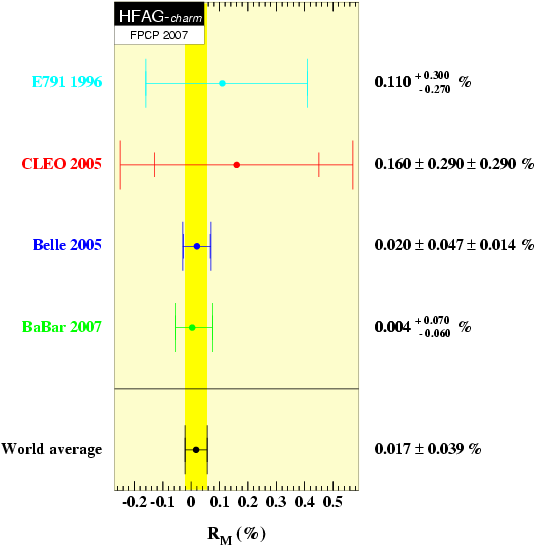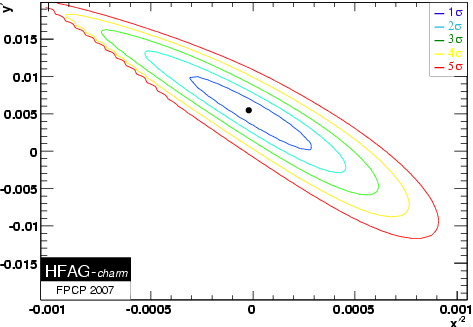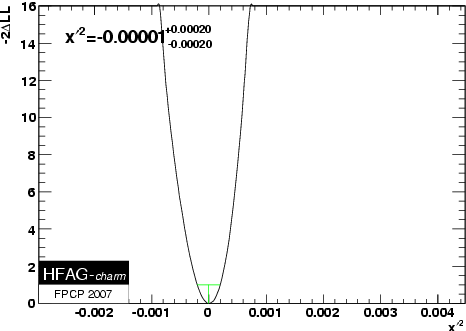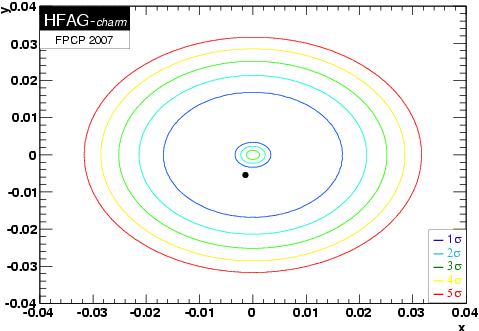
(assuming CP conservation) People working on this: David Asner, Bostjan Golob, Brian Petersen, Alan Schwartz
For a complete list of references click here
For mixing results allowing for CP violation click here
Notation: the mass eigenstates are denoted
D 1 ≡ p|D0> +
q|D0> and
D 2 ≡ p|D0> −
q|D0>;
R D is the ratio of magnitudes of
D0
→ f and D0 → f amplitudes;
and δ (φ) is the strong (weak) phase difference between
D0
→ f and D0 → f amplitudes.
This page is organized as follows. First, "pure" measurements
and their world averages are presented:
D0 → K+l− ν results for R M ≡ (x2+y2)/2.
| Year | Experiment | Result | Comment | |||||
|---|---|---|---|---|---|---|---|---|
| 1996 | FNAL E791 | R M = (0.11 +0.30 −0.27 +0.00 −0.014 )% | 500 GeV π −N interactions (2 × 1010 events) | |||||
| 2005 | CLEO II.V | R M = (0.16 ± 0.29 ± 0.29 )% | 9.0 fb−1 near Υ(4S) resonance | |||||
| 2004 | BaBar | R M = (0.23 ± 0.12 ± 0.04 )% | 87 fb−1 near Υ(4S) resonance | |||||
| 2005 | Belle | R M = (0.020 ± 0.047 ± 0.014 )% | 253 fb−1 near Υ(4S) resonance | |||||
| 2007 | BaBar | R M = (0.004 +0.070 −0.060 )% |
|
|||||
| COMBOS average |
|
|
D0 → K+ K−, π+ π− results for: y CP ≡ [Γ(CP+)/<Γ>]−1 = (1/2)(|q/p| + |p/q|) y cosφ − (1/2)(|q/p| − |p/q|) x sin φ, and A Γ ≡ [τ(D0 → K+ K−) − τ(D0 → K+ K− )] / [τ(D0 → K+ K−) + τ(D0 → K+ K− )] = (1/2)(|q/p|−|p/q|) y cosφ −(1/2)(|q/p|+|p/q|) x sin φ .
| Year | Experiment | Result | Comment | ||||||||
|---|---|---|---|---|---|---|---|---|---|---|---|
| 1999 | FNAL E791 | ΔΓ = (0.04 ± 0.14 ± 0.05 ) ps −1 | 500 GeV π −N interactions (2 × 1010 events) | ||||||||
| 2000 | FOCUS | y CP = (3.42 ± 1.39 ± 0.74 )% | γN interactions (1 × 106 reconstr. D → K n(π) decays) | ||||||||
| 2002 | CLEO II.V | y CP = (−1.2 ± 2.5 ± 1.4 )% | 9.0 fb−1 near Υ(4S) resonance | ||||||||
| 2003 | BaBar |
|
91 fb−1 near Υ(4S) resonance | ||||||||
| 2002 | Belle | y CP = (−0.5 ± 1.0 +0.7 −0.8 )% | 23.4 fb−1 near Υ(4S) resonance; no D* tag | ||||||||
| 2007 | Belle |
|
540 fb−1 near Υ(4S) resonance | ||||||||
| COMBOS average |
|
|
Plot of y CP average: Plot of A Γ average:
Likelihood function: [LF #1]
D0 → K+ π − results for R D, x' ≡ x cosδ + y sin δ, y' ≡ y cosδ - x sin δ, and R B ≡ R D + y' √ R D + (x2+y2)/2 . These results assume no CPV.
| Year | Experiment | Result | Comment | ||||
|---|---|---|---|---|---|---|---|
| 1998 | FNAL E791 | RB = (0.68 +0.34 −0.33 ± 0.07)% | 500 GeV π −N interactions (2 × 1010 events) | ||||
| 2000 | CLEO II.V |
|
9.0 fb−1 near Υ(4S) resonance | ||||
| 2005 | FOCUS |
|
γN interactions (1 × 106 reconstr. D → K n(π) decays) | ||||
| 2006 | Belle |
|
400 fb−1 near Υ(4S) resonance | ||||
| 2006 | CDF (Run II) | RB = (0.405 ± 0.021 ± 0.011)% | 0.35 fb−1 at √s = 1.96 TeV | ||||
| 2007 | BaBar |
|
384 fb−1 near Υ(4S) resonance |
To combine K+ π − results, the three-dimensional log(likelihood) functions for (x'2, y', RD) are added (Belle + BaBar only) . The resulting function is mapped onto the (x'2, y') plane as follows: for a specific (x'2, y') value, the parameter RD is allowed to seek its preferred value, and the resulting likelihood is assigned. The function is mapped onto the RD axis as follows: for a specific RD value, the parameters x'2 and y' are allowed to seek their preferred values, and the resulting likelihood is assigned.
To map the (x'2, y') likelihood function to an (x, y, δ) likelihood volume, the (x, y, δ) space is scanned and, at each point, (x'2, y') is calculated and the corresponding likelihood assigned. Note that this likelihood value must come from the physical region of the (x'2, y') plane, i.e., positive x'2.
To map the (x, y, δ) likelihood volume onto the (x, y) plane, the (x, y) space is scanned and, at each point, the parameter δ is allowed to seek its preferred value, and the corresponding likelihood is assigned.
Belle + BaBar (x'2, y') projection:
x'2 projection:


(x'2, y') → (x, y) mapped likelihood
[LF #2] :

D0 → K+ π − π 0 and K+ π − π + π − results for R B, R M, <R D>, and α<y'>, where <…> denotes a quantity integrated (or averaged) over the selected phase-space region of the Dalitz plot, and α is a suppression factor in the range (0,1) arising from strong phase differences over the Dalitz plot. These results assume no CPV.
| Year | Experiment | Result | Comment | |||||
|---|---|---|---|---|---|---|---|---|
| 2005 | Belle |
|
281 fb−1 near Υ(4S) resonance | |||||
| 2006 | BaBar |
|
230.4 fb−1 near Υ(4S) resonance | |||||
| 2006 | BaBar |
|
230.4 fb−1 near Υ(4S) resonance |
D0 → K0S π+ π − results. These results assume no CPV.
| Year | Experiment | Result | Comment | |||||
|---|---|---|---|---|---|---|---|---|
| 2005/2007 | CLEO II.V |
|
|
|||||
| 2007 | Belle |
|
540 fb−1 near Υ(4S) resonance | |||||
| COMBOS average |
|
|
Likelihood function in (x, y) plane [LF #3] :
Ψ(3770) → D0-D0 results, using correlations. The errors are statistical only.
| Year | Experiment | Result | Comment | |||
|---|---|---|---|---|---|---|
| 2006 | CLEO-c |
|
0.281 fb−1 at Ψ(3770) resonance |
Likelihood function for δ [LF #4] :
| Year | Measurement | Result | Comment | |||
|---|---|---|---|---|---|---|
| All D0 → K+l− ν |
|
|
||||
| 2006 | BaBar D0 → K+ π π |
|
230.4 fb−1 near Υ(4S) resonance | |||
| 2006 | BaBar D0 → K+ π π π |
|
230.4 fb−1 near Υ(4S) resonance | |||
| 2006 | CLEO-c |
|
0.281 fb−1 at Ψ(3770) resonance | |||
| COMBOS average |
|
|
Plot of overall average: Likelihood function in (x, y) plane [LF #5] :
y combination assuming y CP =y, and that y from D0 → KS π+ π - corresponds to [Γ(CP+)−Γ(CP−)]/(2Γ).
| Year | Measurement | Result | Comment | |||||
|---|---|---|---|---|---|---|---|---|
| All yCP |
|
|
||||||
| All D0 → KS π+ π - |
|
|
||||||
| 2006 | CLEO-c |
|
0.281 fb−1 at Ψ(3770) resonance | |||||
| COMBOS average |
|
|
Plot of overall average:
Combination of all data assuming no CP violation (y CP =y) and
that y from D0 → KS π+ π -
corresponds to [Γ(CP+)−Γ(CP−)]/(2Γ).
To combine all results,
we convert each measurement to a likelihood function in
(x, y, δ) space and sum the log(likelihoods).
The input likelihood functions are shown above:
LF #1,
LF #2,
LF #3,
LF #4,
LF #5.
The resulting (x, y, δ) likelihood function is mapped to the (x, y) plane as follows: for a specific (x, y) value, the parameter δ is allowed to seek its preferred value, and the corresponding likelihood is assigned.
To map the likelihood function to the x axis: for a specific x value, the parameters y and δ are allowed to seek their preferred values, and the corresponding likelihood is assigned.
To map the likelihood function to the y axis: for a specific y value, the parameters δ and x are allowed to seek their preferred values, and the corresponding likelihood is assigned.
To map the likelihood function to the δ axis: for a specific δ value, the parameters x and y are allowed to seek their preferred values, and the corresponding likelihood is assigned.
Overall likelihood function in (x, y) plane: Overall likelihood function for δ :
Overall likelihood function for x: Overall likelihood function for y:
Last modified 3 Dec 2007. Send comments to A. Schwartz or M. Purohit